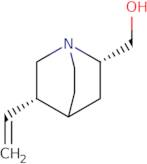Quincorine
CAS: 207129-35-9
Rif. 3D-FQ59913
| 1g | Fuori produzione | ||
| 50mg | Fuori produzione | ||
| 100mg | Fuori produzione | ||
| 250mg | Fuori produzione | ||
| 500mg | Fuori produzione |
Informazioni sul prodotto
- (1S,2S,5S)-2-(Hydroxymethyl)-5-vinylquinuclidine(1S,2S,5S)-5-Vinyl-2-quinuclidinemethanol
- (1S,2S,4S,5R)-5-Ethenyl-1-azabicyclo[2.2.2]octane-2-methanol
- (5-Vinyl-1-azabicyclo[2.2.2]oct-2-yl)methanol
- 1-Azabicyclo[2.2.2]Octane-2-Methanol, 5-Ethenyl-
- 1-Azabicyclo[2.2.2]octane-2-methanol, 5-ethenyl-, (1S,2S,4S,5R)-
- 1-Azabicyclo[2.2.2]octane-2-methanol, 5-ethenyl-, [1S-(1α,2α,4α,5β)]-
- [(2S,4S,5R)-5-vinylquinuclidin-2-yl]methanol
Quincorine is a palladium complex immobilized on a solid catalyst that is used for the asymmetric synthesis of β-amino acids. Quincorine has been shown to be an effective catalyst for the enantioselective synthesis of β-amino acids using amines, amino alcohols and nitrogen heterocycles. It can also be used as a catalyst in the cross-coupling reaction between amines and carbonyl groups. The active form of quincorine is a palladium complex with two nitrogen atoms, which are nucleophilic attack sites that can bind to hydrogen bonds or carbonyl groups. Quincorine has been shown to have anti-inflammatory properties in vitro and in vivo, which may be due to its ability to inhibit prostaglandin synthesis.





